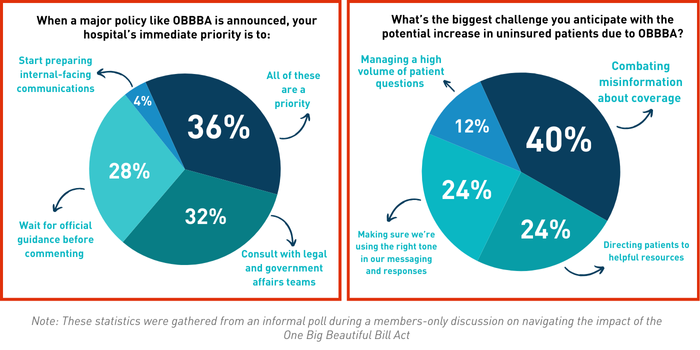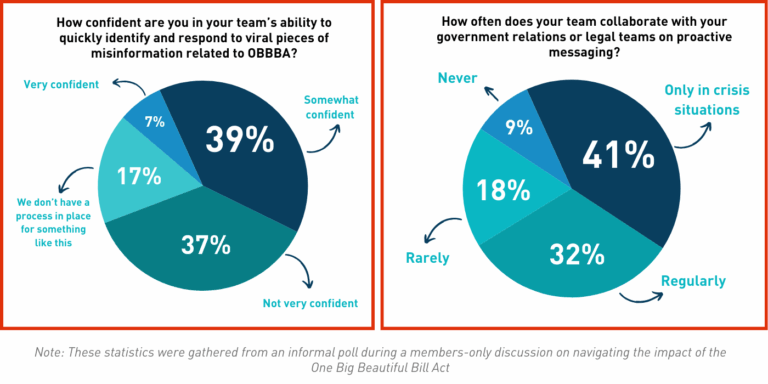Key takeaways:
- Take a cautious, risk-averse approach when discussing the One Big Beautiful Bill Act. Most healthcare organizations remain hesitant to take public stances due to potential investigations and financial vulnerabilities.
- Focus on educational content that highlights community impact through patient stories, research contributions, and essential services — demonstrating value without directly criticizing legislation.
- Combat misinformation about healthcare coverage while finding credible sources of truth in an increasingly polarized information landscape.
The One Big Beautiful Bill Act (OBBBA), signed into law by President Trump on July 4, 2025, is now reshaping the healthcare landscape, and hospital social media leaders across the country are grappling with a complex challenge: how to communicate effectively about legislation that could fundamentally reshape patient care while navigating heightened political sensitivities and organizational risk aversion.
In a recent confidential discussion among SocialMedia.org Health members, social media leaders from major hospital systems shared their approaches to this unprecedented situation.
When asked about their hospital’s immediate priority when major policy like OBBBA is announced, responses were split: 36% said all options are priorities, 32% prioritize consulting with legal and government affairs teams, 28% wait for official guidance before commenting, and just 4% focus on preparing internal communications first.
The conversation revealed a healthcare industry caught between its mission to serve patients and the reality of operating in an increasingly politicized environment.
Choose Strategic Silence Over Hasty Public Statements

The overwhelming sentiment among hospital social media leaders is caution. Many organizations are adopting what one leader described as a “fight, flight, or freeze” mentality — and most are choosing to freeze.
Academic medical centers are taking an extremely conservative approach, with some completely halting all messaging related to governmental issues until ongoing federal scrutiny resolves. This stance reflects the reality that many health systems are already under the spotlight for various regulatory matters, making them hesitant to attract additional attention.
This cautious approach is understandable given that most hospital communications teams work with government relations and legal teams primarily in crisis situations rather than for proactive messaging.
According to community polling, 41% collaborate with these departments only during crises, 32% work with them regularly, 18% rarely engage, and 9% never collaborate on proactive messaging.
The financial stakes are enormous for these organizations. Members describe having billions of dollars at risk and facing potential investigations, making public statements about federal legislation particularly precarious. Even systems that have prepared statements are treating them strictly as reactive tools — developed for media requests rather than proactive communication.
One health system social media leader explained that while they have messaging ready, it’s intended only for responding to direct inquiries from news outlets, not for pushing out through their own channels.
Demonstrate Value Through Community Impact Stories
While most hospitals remain cautious, some are taking more proactive approaches through carefully crafted educational campaigns. These strategies focus on demonstrating community value without directly engaging in political advocacy.
One multi-state health system has developed a comprehensive educational campaign that will launch nationally while tailoring messaging to local markets. Their approach includes patient testimonials, caregiver stories, and partnerships with community organizations to help patients find resources like subsidized care and free programs.
The campaign aims to educate communities about the bill’s most important aspects, particularly where Medicaid access is threatened, while showcasing innovations in improving healthcare access.
Another organization is implementing what they call a “flood the zone” strategy — amplifying high-performing content that showcases community impact. The goal is to help people understand the essential role their hospital plays without explicitly stating it.
This approach includes repurposing successful patient stories and highlighting research contributions to demonstrate the hospital’s value to the community.
Combat Misinformation and Build Credible Networks Before Crises Happen

Perhaps the most daunting challenge facing hospital social media teams is the prospect of combating misinformation about healthcare coverage in an environment where traditional sources of authority have been undermined.
This concern is well-founded: 40% of hospital social media leaders identify combating misinformation about coverage as their biggest anticipated challenge, while 24% are focused on directing patients to helpful resources and another 24% worry about maintaining the right tone in messaging and responses.
The confidence levels around misinformation response are concerning. Only 9% of members feel very confident in their team’s ability to quickly identify and respond to viral misinformation related to OBBBA, while 39% are somewhat confident and 35% are not very confident. Most telling, 17% admit they don’t have a process in place for something like this at all.
During the pandemic, healthcare organizations could direct patients to government websites as trusted sources of information. That option may no longer be viable, leaving hospitals searching for credible alternatives that carry broad institutional backing. The need for a unified source of truth backed by major hospitals across the country has become increasingly apparent.
The challenge is compounded by what leaders describe as an increasingly polarized information landscape. People tend to trust different media sources and resist alternative viewpoints, with many defaulting to either conservative or liberal news outlets rather than seeking balanced perspectives from multiple sources.
This fragmentation makes it difficult for any single organization, even a respected hospital system, to serve as an authoritative voice.
Hospital social media leaders are recognizing that some audiences will be receptive to their messaging while others will remain skeptical regardless of the source, often for political reasons.
Prepare Communication Strategies Despite Resource Constraints
Beyond communication challenges, many hospital systems are already experiencing the financial impacts of anticipated changes, creating additional constraints on their ability to respond effectively.
Some have implemented significant budget cuts, with one system reducing their budget by $300 million and undergoing substantial workforce reductions. These cuts directly impact social media capabilities, with communications teams losing significant staff members and facing limitations on their ability to execute comprehensive strategies.
Others are reconsidering whether to backfill social media positions as they become vacant. The anticipated financial impact of the legislation is causing organizations to put hiring on hold, even for critical communications roles. This creates a challenging cycle where hospitals need stronger communication capabilities to navigate the crisis but lack the resources to build those capabilities.
Plan for December Enrollment Changes and Beyond
Members said they are preparing for several key milestones that could significantly impact their patient populations and communication strategies. The most immediate concerns center around changes to Affordable Care Act marketplace enrollment, with shorter enrollment windows and the potential elimination of premium subsidies.
The enrollment deadline has moved from January 15 to December 15, and automatic re-enrollment has been eliminated, potentially creating confusion among patients accustomed to the previous system. Additionally, premium subsidies face uncertainty if Congress doesn’t act to renew them, which could significantly impact patients’ ability to afford coverage.
These changes are expected to result in more uninsured patients seeking care in emergency departments, creating both operational challenges and new communication needs for hospital social media teams.
Members anticipate that patients will delay preventive care and present with more advanced conditions, driving up costs and complexity of care.
Connect With Peers to Navigate Complex Healthcare Communications
For social media leaders in healthcare, the One Big Beautiful Bill Act represents more than a policy challenge — it’s a test of how effectively they can serve their communities during times of uncertainty while maintaining the trust and credibility that makes their institutions essential sources of care and information.
The strategies emerging from this challenge will likely influence how you approach sensitive political topics for years to come, making the current moment a critical one for the future of healthcare communication.
Join SocialMedia.org Health today to connect with other hospital social media leaders who are navigating these complex challenges. Our confidential, peer-led community provides the insights and support you need to develop effective strategies while managing organizational risk in an increasingly complex healthcare landscape.
